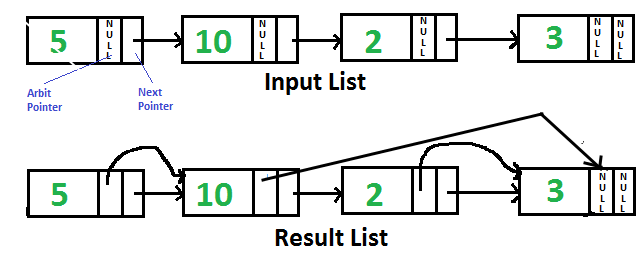Python Program For Pointing Arbit Pointer To Greatest Value Right Side Node In A Linked List
Last Updated :
03 May, 2023
Given singly linked list with every node having an additional “arbitrary” pointer that currently points to NULL. We need to make the “arbitrary” pointer to the greatest value node in a linked list on its right side.

A Simple Solution is to traverse all nodes one by one. For every node, find the node which has the greatest value on the right side and change the next pointer.
Below is the implementation of the above approach:
Python3
class Node:
def __init__(self, data):
self.data = data
self.next = None
self.arbit = None
def reverse(head):
prev = None
current = head
next = None
while (current != None):
next = current.next
current.next = prev
prev = current
current = next
return prev
def populateArbit(head):
head = reverse(head)
max = head
temp = head.next
while (temp != None):
temp.arbit = max
if (max.data < temp.data):
max = temp
temp = temp.next
return reverse(head)
def printNextArbitPointers(node):
print("Node ", "Next Pointer " , "Arbit Pointer")
while (node != None):
print(node.data , " ", end = "")
if (node.next != None):
print(node.next.data , " ", end = "")
else :
print("NULL" , " ",end = "")
if (node.arbit != None):
print(node.arbit.data, end = "")
else :
print("NULL", end = "")
print("")
node = node.next
def newNode(data):
new_node = Node(0)
new_node.data = data
new_node.next = None
return new_node
head = newNode(5)
head.next = newNode(10)
head.next.next = newNode(2)
head.next.next.next = newNode(3)
head = populateArbit(head)
print("Resultant Linked List is: ")
printNextArbitPointers(head)
|
Output
Resultant Linked List is:
Node Next Pointer Arbit Pointer
5 10 10
10 2 3
2 3 3
3 NULL NULL
The Time Complexity of this above solution is O(n2).
Space complexity:
The space complexity of the program is O(1) as it uses a constant amount of extra space irrespective of the input size.
An Efficient Solution can work in O(n) time. Below are the steps.
- Reverse the given linked list.
- Start traversing the linked list and store the maximum value node encountered so far. Make arbit of every node to point to max. If the data in the current node is more than the max node so far, update max.
- Reverse modified linked list and return head.
Following is the implementation of the above steps.
Python
class Node:
def __init__(self, data):
self.data = data
self.next = None
self.arbit = None
def reverse(head):
prev = None
current = head
next = None
while (current != None):
next = current.next
current.next = prev
prev = current
current = next
return prev
def populateArbit(head):
head = reverse(head)
max = head
temp = head.next
while (temp != None):
temp.arbit = max
if (max.data < temp.data):
max = temp
temp = temp.next
return reverse(head)
def printNextArbitPointers(node):
print("Node ",
"Next Pointer " ,
"Arbit Pointer")
while (node != None):
print(node.data ,
" ",
end = "")
if (node.next != None):
print(node.next.data ,
" ", end = "")
else :
print("NULL" ,
" ",end = "")
if (node.arbit != None):
print(node.arbit.data, end = "")
else :
print("NULL", end = "")
print("")
node = node.next
def newNode(data):
new_node = Node(0)
new_node.data = data
new_node.next = None
return new_node
head = newNode(5)
head.next = newNode(10)
head.next.next = newNode(2)
head.next.next.next = newNode(3)
head = populateArbit(head)
print("Resultant Linked List is: ")
printNextArbitPointers(head)
|
Output
Resultant Linked List is:
Node Next Pointer Arbit Pointer
5 10 10
10 2 3
2 3 3
3 NULL NULL
The time complexity of this program is O(n), where n is the number of nodes in the linked list.
The space complexity of this program is also O(n), as it creates a new node for each element in the list and stores them in memory.
Recursive Solution:
We can recursively reach the last node and traverse the linked list from the end. The recursive solution doesn’t require reversing of the linked list. We can also use a stack in place of recursion to temporarily hold nodes. Thanks to Santosh Kumar Mishra for providing this solution.
Python3
class newNode:
def __init__(self, data):
self.data = data
self.next = None
self.arbit = None
maxNode = newNode(None)
def populateArbit(head):
global maxNode
if (head == None):
return
if (head.next == None):
maxNode = head
return
populateArbit(head.next)
head.arbit = maxNode
if (head.data > maxNode.data and
maxNode.data != None ):
maxNode = head
return
def printNextArbitPointers(node):
print("Node " ,
"Next Pointer " ,
"Arbit Pointer")
while (node != None):
print(node.data,
" ",
end = "")
if(node.next):
print(node.next.data,
" ",
end = "")
else:
print("NULL", " ",
end = "")
if(node.arbit):
print(node.arbit.data, end = "")
else:
print("NULL", end = "")
print()
node = node.next
head = newNode(5)
head.next = newNode(10)
head.next.next = newNode(2)
head.next.next.next = newNode(3)
populateArbit(head)
print("Resultant Linked List is:")
printNextArbitPointers(head)
|
Output
Resultant Linked List is:
Node Next Pointer Arbit Pointer
5 10 10
10 2 3
2 3 3
3 NULL NULL
Please refer complete article on Point arbit pointer to greatest value right side node in a linked list for more details!
Like Article
Suggest improvement
Share your thoughts in the comments
Please Login to comment...